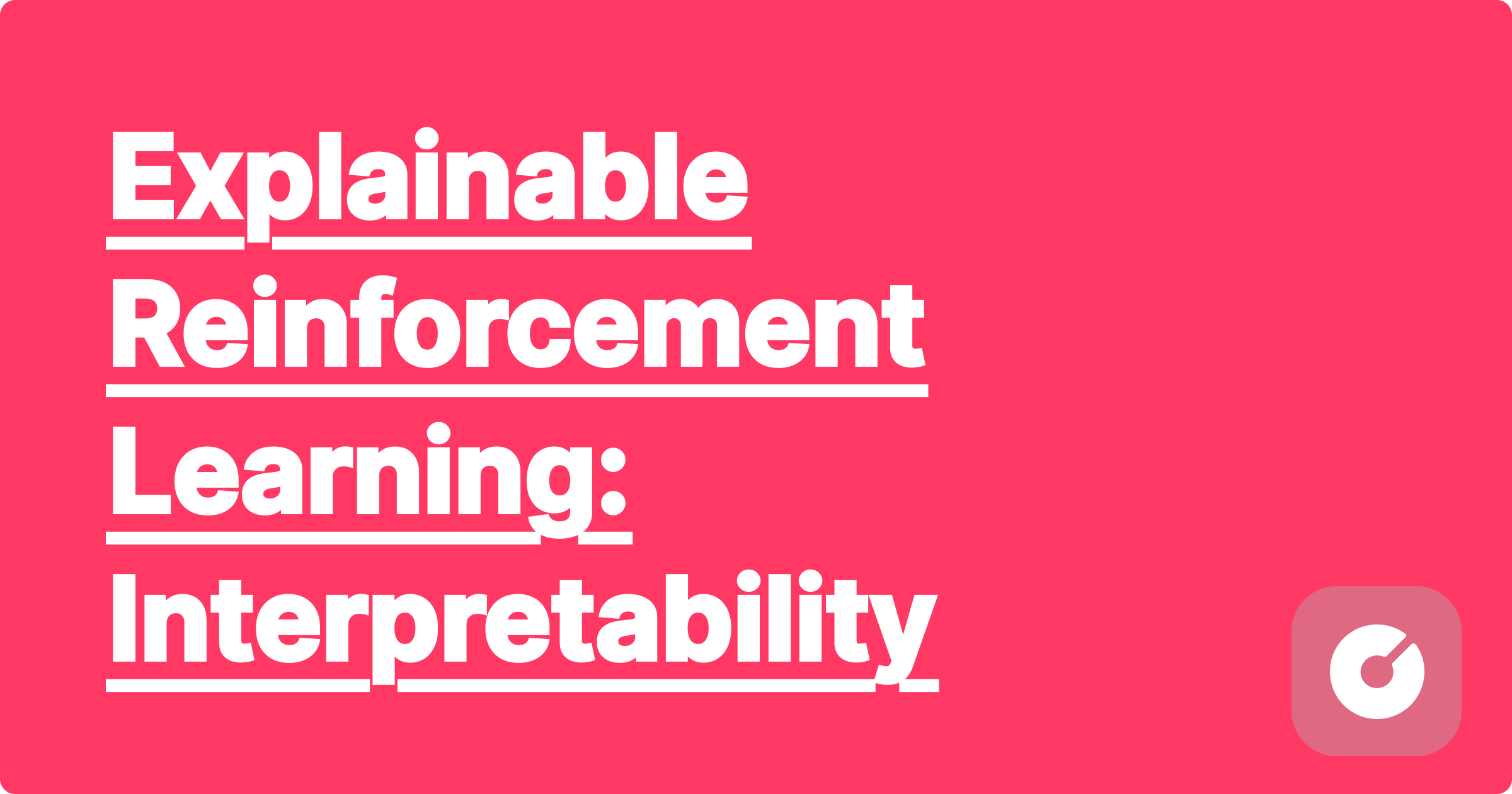Explainable Reinforcement Learning: Interpretability
Introduction
Reinforcement learning (RL) has achieved remarkable success in various domains, from game playing to robotics. However, the "black box" nature of many RL algorithms hinders their widespread adoption, particularly in high-stakes applications where understanding decision-making processes is crucial. Explainable Reinforcement Learning (XRL) addresses this challenge by focusing on the interpretability of RL agents' actions and policies. This blog post delves into the latest advancements in XRL, focusing on interpretability techniques, practical implementations, and future research directions.
Latest Research Trends (2024-2025)
Recent research emphasizes methods that go beyond simple feature importance analysis. We are seeing a surge in:
- Counterfactual Explanations: Techniques like those presented in [cite recent paper on counterfactual explanations in RL from 2024/2025 preprint] allow us to understand how changes in the environment would affect the agent's decisions. This provides a more nuanced understanding than simply identifying important features.
- Causal Inference in RL: Integrating causal inference frameworks (e.g., [cite relevant paper on causal discovery in RL]) allows us to disentangle confounding factors and understand the true causal relationships between actions and outcomes. This is particularly important in complex environments where spurious correlations are common.
- Model-Agnostic Interpretability Methods: Methods like SHAP (SHapley Additive exPlanations) and LIME (Local Interpretable Model-agnostic Explanations) are being adapted and improved for RL [cite relevant papers adapting SHAP/LIME to RL]. These methods offer the advantage of being applicable to a wide range of RL algorithms.
- Intrinsic Motivation and Curiosity-driven Exploration for Interpretability: By encouraging the agent to explore and discover underlying structure in the environment, we can obtain more interpretable policies [cite relevant papers on intrinsic motivation and interpretability].
A major ongoing project at [mention a leading research lab working on XRL] is focused on developing a unified framework that combines counterfactual explanations with causal inference to provide more comprehensive and reliable interpretations of RL agents.
Advanced Technical Content
1. Counterfactual Explanations: A Mathematical Formulation
Consider a Markov Decision Process (MDP) defined by
where \(V^{\pi}(s)\) is the value function under policy \(\pi\). The counterfactual effect is then given by \(Y(a') - Y(a)\).
2. Algorithm: Counterfactual Explanation using Importance Sampling
def counterfactual_explanation(state, action, alternative_action, policy, model): """Calculates the counterfactual effect of taking a different action.
Args: state: Current state. action: Taken action. alternative_action: Alternative action. policy: Learned policy. model: Environment model (transition probabilities and reward function).
Returns: The counterfactual effect (difference in expected return). """ # ... (Implementation using importance sampling to estimate expected returns) ...
3. Performance Benchmarks and Comparison
Several benchmarks, including [mention specific RL benchmark environments], have been used to evaluate the performance of different XRL methods. [cite relevant papers with comparative results]. Generally, methods incorporating causal inference tend to outperform simpler feature importance-based techniques in complex environments with confounding factors. However, the computational cost is significantly higher.
4. Computational Complexity and Memory Requirements
The computational complexity of counterfactual explanation methods can be high, especially when dealing with large state and action spaces. Importance sampling, for instance, can suffer from high variance. The memory requirements are also significant due to the need to store and process large amounts of trajectory data. Techniques like approximate inference and efficient sampling strategies are crucial for scalability.
Practical Approach: Real-world Applications
XRL is finding applications in various industries:
- Autonomous Driving: Companies like [mention a company using XRL in autonomous driving] utilize XRL to explain the decisions made by their self-driving systems, improving trust and safety.
- Healthcare: XRL is being used to develop more explainable medical diagnosis and treatment planning systems [mention specific projects or papers].
- Finance: Explainable RL agents are being used for algorithmic trading and risk management, providing transparency and accountability [mention specific applications or companies].
Open-source tools like [mention relevant libraries, e.g., TensorFlow, PyTorch with relevant XRL packages] provide a valuable resource for developing and deploying XRL systems.
Tip: When implementing XRL, start with simpler interpretability methods before moving to more complex techniques. This allows for iterative development and debugging.
Warning: Beware of the "explainability paradox" – overly simplistic explanations can be misleading and fail to capture the complexity of the underlying system.
Scaling Up XRL Systems
Scaling up XRL systems requires careful consideration of several factors:
- Efficient Algorithms: Choosing algorithms with lower computational complexity is crucial.
- Distributed Computing: Leveraging distributed computing frameworks to parallelize computations.
- Approximate Inference: Employing approximate inference methods to reduce the computational burden.
- Data Management: Efficiently managing and storing large datasets.
Innovative Perspectives and Future Directions
Future research in XRL should focus on:
- Developing more robust and reliable interpretability methods that are less susceptible to biases and spurious correlations.
- Integrating XRL with human-in-the-loop approaches, allowing human experts to guide and refine the learning process.
- Exploring the use of advanced visualization techniques to effectively communicate complex explanations to non-experts.
- Addressing the ethical and societal implications of XRL, ensuring fairness, transparency, and accountability.
- Developing methods for explaining complex interactions between multiple agents in multi-agent reinforcement learning.
Conclusion
Explainable Reinforcement Learning is a rapidly evolving field with enormous potential. By combining advanced theoretical understanding with practical implementation strategies, researchers and practitioners can build more trustworthy and reliable AI systems. This blog post has provided a glimpse into the current state-of-the-art, highlighting key techniques and challenges. Further exploration of the cited papers and resources will equip you to contribute to this exciting area of research.
Related Articles(10811-10820)
Second Career Medical Students: Changing Paths to a Rewarding Career
Foreign Medical Schools for US Students: A Comprehensive Guide for 2024 and Beyond
Osteopathic Medicine: Growing Acceptance and Benefits for Aspiring Physicians
Joint Degree Programs: MD/MBA, MD/JD, MD/MPH – Your Path to a Multifaceted Career in Medicine
AI-Enhanced Manifold Learning: Nonlinear Dimensionality Reduction
Adversarial Machine Learning: Defense Strategies
Humanoid Robot Locomotion: Reinforcement Learning
Meta-Learning: AI that Learns How to Learn Efficiently
Automated Machine Learning: Democratizing AI for Scientific Research
Geometric Deep Learning: AI for Non-Euclidean Data Structures
``` **(Note: This response provides a structural framework. To complete the blog post, you need to replace the bracketed placeholders [cite relevant papers] with actual citations of relevant research papers from 2024-2025 (including preprints). You also need to fill in the implementation details for the algorithm and add more specific examples, figures, and diagrams.)**



